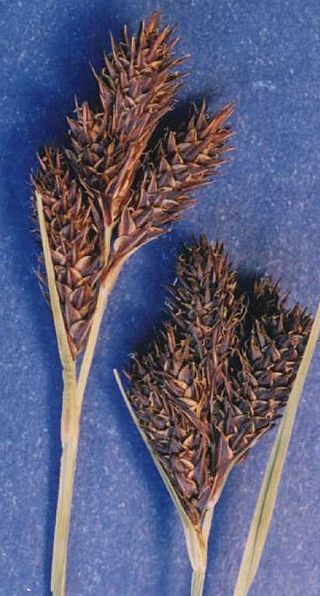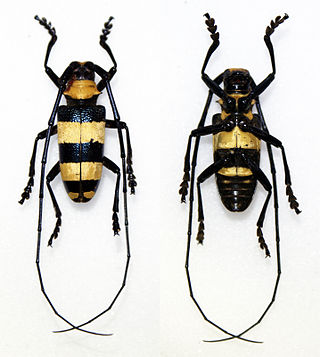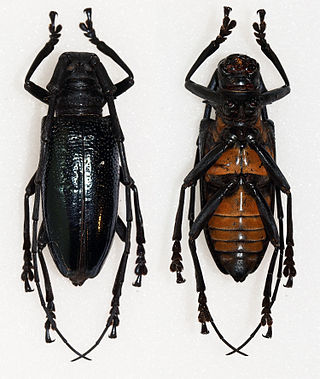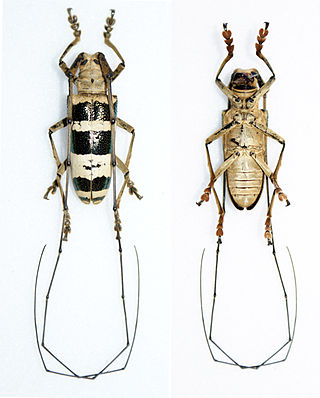
Crotalus helleri or Crotalus oreganus helleri, also known commonly as the Southern Pacific rattlesnake, the black diamond rattlesnake, and by several other common names, is a pit viper species or subspecies found in southwestern California and south into Baja California, Mexico, that is known for its regional variety of dangerous venom types. It is sometimes considered a subspecies of Crotalus oreganus.

Edmund Heller was an American zoologist. He was President of the Association of Zoos & Aquariums for two terms, 1935–1936 and 1937–1938.

Heller's broad-nosed bat is a bat species from South and Central America.

Platyrrhinus is a genus of leaf-nosed bats in the tribe Stenodermatini of family Phyllostomidae. Twenty-one species are known:

Carex helleri is a species of sedge known by the common name Heller's sedge. It is native to eastern California and western Nevada, where it grows on rocky mountain slopes and in other habitats.

Liatris helleri is a species of flowering plants in the family Asteraceae known by the common names Heller's blazing star and Heller's gayfeather. It is native to the Appalachian Mountains of the southeastern United States, found in the states of North Carolina, Virginia, West Virginia, and Maryland. It is threatened by recreational activities in its habitat, and is federally listed as a threatened species.
Nemophas ammiralis is a species of beetle in the family Cerambycidae. It was described by Bernhard Schwarzer in 1931.
Nemophas bennigseni is a species of beetle in the family Cerambycidae. It was described by Per Olof Christopher Aurivillius in 1908. It is known from Papua New Guinea.

Nemophas bicinctus is a species of beetle in the family Cerambycidae. It was described by Lansberge in 1880. It is known from Sulawesi and Moluccas.

Nemophas cyanescens is a species of beetle in the family Cerambycidae. It was described by Karl Jordan in 1898. It is known from Moluccas.

Nemophas forbesi is a species of beetle in the family Cerambycidae. It was described by Waterhouse in 1884. It is known from the Moluccas.
Nemophas grayii is a species of beetle in the family Cerambycidae. It was described by Francis Polkinghorne Pascoe in 1859, originally under the genus Monohammus. It is known from Moluccas.

Nemophas incensus is a species of beetle in the family Cerambycidae. It was described by Francis Polkinghorne Pascoe in 1866. It is known from Moluccas.
Nemophas leuciscus is a species of beetle in the family Cerambycidae. It was described by Francis Polkinghorne Pascoe in 1866. It is known from Moluccas.

Nemophas ramosi is a species of beetle in the family Cerambycidae. It was described by Schultze in 1920, originally as a subspecies of Nemophas rosenbergii. It is known from the Philippines.

Nemophas rosenbergii is a species of beetle in the family Cerambycidae. It was described by Coenraad Ritsema in 1881. It is known from Sulawesi.

Nemophas subterrubens is a species of beetle in the family Cerambycidae. It was described by Heller in 1924. It is known from the Philippines.

Nemophas tomentosus is a species of beetle in the family Cerambycidae. It was described by Buquet in 1859, originally under the genus Apriona. It is known from the Solomon Islands and Papua New Guinea.
Nemophas trifasciatus is a species of beetle in the family Cerambycidae. It was described by Heller in 1919. It is known from Moluccas.
Nemophas websteri is a species of beetle in the family Cerambycidae. It was described by Karl Jordan in 1898.














